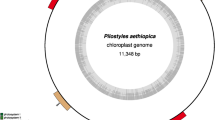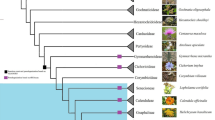Summary
The trnK gene endocing the tRNALys (UUU) has been located on mustard (Sinapis alba) chloroplast DNA, 263 by upstream of the psbA gene on the same strand. The nucleotide sequence of the trnK gene and its flanking regions as well as the putative transcription start and termination sites are shown. The 5′ end of the transcript lies 121 by upstream of the 5′ tRNA coding region and is preceded by procaryotic-type “−10” and “−35” sequence elements, while the 3′ end maps 2.77 kb downstream to a DNA region with possible stem-loop secondary structure. The anticodon loop of the tRNALys is interrupted by a 2,574 by intron containing a long open reading frame, which codes for 524 amino acids. Based on conserved stem and loop structures, this intron has characteristic features of a class II intron. A region near the carboxyl terminus of the derived polypeptide appears structurally related to maturases.
Similar content being viewed by others
Abbreviations
- bp:
-
base pairs
- psbA:
-
gene coding for the Mr 32,000 herbicide binding photosystem II protein
- COI:
-
cytochrome c oxidase subunit I
- trnK:
-
gene coding for chloroplast tRNALys
References
Berk AJ, Sharp PA (1977) Cell 12:721–732
Biggin MD, Gibson TJ, Hong GF (1983) Proc Natl Acad Sci USA 80:3963–3965
Bonitz SG, Coruzzi G, Thalenfeld BE, Tzagoloff A (1980) J Biol Chem 255:11927–11941
Bonnard G, Michel F, Weil JH, Steinmetz A (1984) Mol Gen Genet 194:330–336
Boyer SK, Mullett JE (1986) Plant Mol Biol 6:229–244
Bradley D, Gatenby AA (1985) EMBO J 4:3641–3648
Burke JM, RajBhandary UL (1982) Cell 31:509–520
Cech T (1983) Cell 34:713–716
Cech T (1986) Cell 44:207–210
Dietrich G, Link G (1985) Curr Genet 9:683–692
Gruissem W, Zurawski G (1985) EMBO J 4:3375–3383
Hanley-Bowdoin L, Orozco EM, Chua N-H (1985) Mol Cell Biol 5:2733–2745
Hawley D, McClure WR (1983) Nucleic Acids Res 11:2237–2255
Keller M, Michel F (1985) FEBS Lett 179:69–73
Koch E, Edwards K, Kössel H (1981) Cell 25:203–213
Kung SD, Lin CM (1985) Nucleic Acids Res 13:7543–7549
Kyte J, Doolittle RF (1982) J Mol Biol 157:105–132
Lang BF, Ahne F, Bonen L (1985) J Mol Biol 184:353–366
Lazowska J, Jacq C, Slonimski PC (1980) Cell 22:333–348
Link G (1981) Nucleic Acids Res 15:3681–3694
Link G (1982) Planta 154:81–86
Link G (1984) EMBO J 3:1697–1704
Link G, Langridge U (1984) Nucleic Acids Res 12:945–957
Maniatis T, Fritsch EF, Sambrook J (eds) (1982) Molecular cloning. A laboratory manual. Cold Spring Harbor Laboratory, Cold Spring Harbor, NY
Margulies L (ed) (1970) Origin of eukaryotic cells. Yale University Press, New Haven
Maxam AM, Gilbert W (1977) Proc Natl Acad Sci USA 74:560–564
Michel F, Dujon B (1983) EMBO J 2:33–38
Michel F, Lang BF (1985) Nature (London) 316:641–643
Osiewacz HD, Esser K (1984) Curr Genet 8:299–305
Przybyl D, Fritzsche E, Edwards K, Kössel H, Falk H, Thompson JA, Link G (1984) Plant Mol Biol 3:147–158
Queen C, Korn LJ (1984) Nucleic Acids Res 12:581–599
Rochaix JD, Rahire M, Michel F (1985) Nucleic Acids Res 13:975–984
Rosenberg M, Court D (1979) Annu Rev Genet 13:319–353
Sanger F, Nicklen S, Coulson ARC (1977) Proc Natl Acad Sci USA 74:5463–5467
Sharp P (1985) Cell 42:397–400
Shinozaki K, Deno H, Sugita M, Kuramitsu S, Sugiura M (1986) Mol Gen Genet 202:1–5
Steinmetz A, Gubbins EJ, Bogorad L (1982) Nucleic Acids Res 10:3027–3037
Strittmatter G, Gozdzicka-Josefiak A, Kössel H (1985) EMBO J 4:599–604
Sugita M, Shinozaki K, Sugiura M (1985) Proc Natl Acad Sci USA 82:3557–3561
Sutcliffe JG (1978) Nucleic Acids Res 5:2721–2728
Takaiwa F, Sugiura M (1982) Nucleic Acids Res 10:2665–2676
Van der Veen R, Arnberg AC, Van der Horst G, Bonen L, Tabak HF, Grivell LA (1986) Cell 44:225–234
Weis-Brummer B, Holl J, Schweyen RJ, Rodel G, Kaudewitz F (1983) Cell 33:195–202
Whitfeld PR, Bottomley W (1983) Annu Rev Plant Physiol 34:279–310
Yanisch-Perron C, Vieira J, Messing J (1985) Gene 33:103–119
Author information
Authors and Affiliations
Rights and permissions
About this article
Cite this article
Neuhaus, H., Link, G. The chloroplast tRNALys(UUU) gene from mustard (Sinapis alba) contains a class II intron potentially coding for a maturase-related polypeptide. Curr Genet 11, 251–257 (1987). https://doi.org/10.1007/BF00355398
Received:
Issue Date:
DOI: https://doi.org/10.1007/BF00355398




